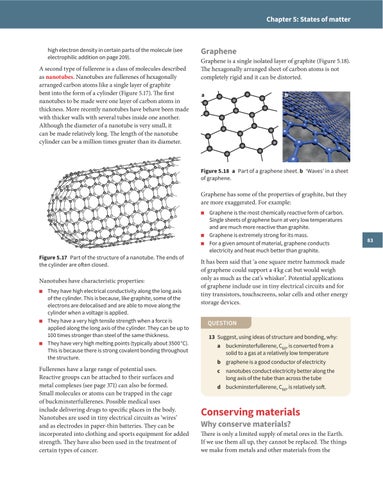Chapter 5: States of matter
high electron density in certain parts of the molecule (see electrophilic addition on page 209).
A second type of fullerene is a class of molecules described as nanotubes. Nanotubes are fullerenes of hexagonally arranged carbon atoms like a single layer of graphite bent into the form of a cylinder (Figure 5.17). The first nanotubes to be made were one layer of carbon atoms in thickness. More recently nanotubes have behave been made with thicker walls with several tubes inside one another. Although the diameter of a nanotube is very small, it can be made relatively long. The length of the nanotube cylinder can be a million times greater than its diameter.
Graphene
Graphene is a single isolated layer of graphite (Figure 5.18). The hexagonally arranged sheet of carbon atoms is not completely rigid and it can be distorted. a
b
Figure 5.18 a Part of a graphene sheet. b ‘Waves’ in a sheet of graphene.
Graphene has some of the properties of graphite, but they are more exaggerated. For example: ■
■ ■
Figure 5.17 Part of the structure of a nanotube. The ends of the cylinder are often closed.
Nanotubes have characteristic properties: ■
■
■
They have high electrical conductivity along the long axis of the cylinder. This is because, like graphite, some of the electrons are delocalised and are able to move along the cylinder when a voltage is applied. They have a very high tensile strength when a force is applied along the long axis of the cylinder. They can be up to 100 times stronger than steel of the same thickness. They have very high melting points (typically about 3500 °C). This is because there is strong covalent bonding throughout the structure.
Fullerenes have a large range of potential uses. Reactive groups can be attached to their surfaces and metal complexes (see page 371) can also be formed. Small molecules or atoms can be trapped in the cage of buckminsterfullerenes. Possible medical uses include delivering drugs to specific places in the body. Nanotubes are used in tiny electrical circuits as ‘wires’ and as electrodes in paper-thin batteries. They can be incorporated into clothing and sports equipment for added strength. They have also been used in the treatment of certain types of cancer.
Graphene is the most chemically reactive form of carbon. Single sheets of graphene burn at very low temperatures and are much more reactive than graphite. Graphene is extremely strong for its mass. For a given amount of material, graphene conducts electricity and heat much better than graphite.
It has been said that ‘a one square metre hammock made of graphene could support a 4 kg cat but would weigh only as much as the cat’s whisker’. Potential applications of graphene include use in tiny electrical circuits and for tiny transistors, touchscreens, solar cells and other energy storage devices. QUESTION 13 Suggest, using ideas of structure and bonding, why: a buckminsterfullerene, C60, is converted from a solid to a gas at a relatively low temperature b graphene is a good conductor of electricity c
nanotubes conduct electricity better along the long axis of the tube than across the tube
d buckminsterfullerene, C60, is relatively soft.
Conserving materials Why conserve materials?
There is only a limited supply of metal ores in the Earth. If we use them all up, they cannot be replaced. The things we make from metals and other materials from the
83
